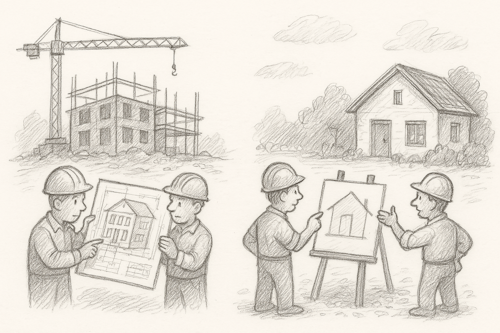The Builders & The Blueprint
Illustrates Architecture, Planning vs Emergent Design, Autonomy
Agile teams often struggle to balance direction with flexibility. Stakeholders want certainty. Teams want clarity. But software is not a house, and Agile is not about executing fixed plans. This parable explores what happens when builders are given a blueprint without room to learn or adapt.

Once there was a company that wanted to build a new innovation hub. Leadership hired a group of builders and handed them a thick blueprint. Every inch of the structure had been decided in advance. Floorplans, materials, even the color of the breakroom chairs.
“Just follow the plan,” the executive said. “It's all been thought through.”
At first, the builders worked eagerly. They followed the diagrams and laid the foundation. But as they progressed, they started to notice problems. The ground wasn't level. The supply of steel beams was delayed. The staircase design blocked sunlight. And the local fire code had recently changed.
The builders raised these concerns. But each time, they were told, “Stick to the blueprint. It's already approved.”
They kept going. They made do. They reworked pieces in secret to keep things moving. Tension grew. Corners were cut. Eventually, the structure was finished, but not functional. The open areas echoed. The conference rooms overheated. And no one wanted to use the expensive innovation hub that had been delivered.
At another site across town, a different team of builders was given a sketch instead of a blueprint. “Here's what we need the building to do,” their sponsor said. “You'll learn more as you build. Talk to the people who'll use it. Adjust as needed.”
That team asked questions. They prototyped. They collaborated. Their design changed over time. When the building opened, it wasn't perfect. But it worked. People used it. It was loved.
Lessons Learned
Fixed Plans Ignore Emerging Truths
The first team was bound to a static design created before ground was even broken. In Agile, this is like trying to predict every Sprint's outcome in advance. Rigid plans prevent learning and adaptation. Change is not failure, it is discovery.
Context Always Wins
The blueprint might have looked perfect on paper, but the builders knew the real context: the site, the weather, the constraints. Teams doing the work often see reality before stakeholders do. Trusting that insight is essential.
Feedback Is Not a Disruption
The second team didn't just execute, they evolved. Agile teams succeed when feedback is expected, welcomed, and acted upon. The first team's feedback was seen as noise. The second team's feedback shaped the solution.
Purpose Guides Better Than Control
When the second team knew the purpose, they had room to adjust. When teams are given a why, not just a what, they can self-organize around outcomes instead of just completing tasks.
Collaboration Beats Compliance
The first team complied with the blueprint but failed to deliver value. The second team collaborated with users and sponsors, creating something usable. Agile frameworks thrive on engagement, not obedience.
Coaching Tips
- Reframe Planning Conversations: Help leaders see plans as starting points, not contracts. Use this parable when roadmaps become overly detailed or fixed.
- Teach the Difference Between Design and Discovery: Remind teams that design thinking and Agile delivery are iterative by nature. They require adjustment along the way.
- Promote Conversations About Purpose: Use this story to shift the focus from features to outcomes. Ask, “What problem are we solving?” instead of “What feature are we building?”
- Model Change as Progress: When teams raise concerns or propose changes, acknowledge this as maturity, not resistance. Like the second team of builders, they are engaging with reality.
Agile delivery is not about perfectly executing a plan. It's about responding to change in pursuit of value. The builders with the blueprint delivered a structure. The builders with the sketch delivered a solution.
If your team feels boxed in by plans that no longer fit, share this parable. Then ask together: Are we building what was designed, or are we building what is needed?


